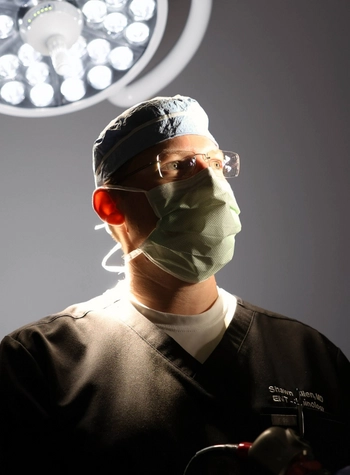Dr. Shawn Allen has either authored or reviewed and approved this content.
Page Updated:Breathe better, sleep better, feel better!
Dr. Shawn Allen is a fellowship-trained Rhinologist and board-certified Ear, Nose & Throat (ENT) specialist who treats patients in Houston and The Woodlands, TX for sinus, nasal, and skull base conditions, as well as obstructive sleep apnea and conditions that cause snoring.

As a Fellowship-trained Rhinologist, Dr. Allen provides the best available care for chronic or recurring sinus problems. He provides the full range of sinus care, ranging from simple office procedures to complex revision sinus surgery normally performed in academic centers. Chronic sinusitis often involves problems with the immune system that persist regardless of the quality of surgery performed. For this reason, Dr. Allen provides ongoing care for chronic sinusitis patients after their surgery and for as long as necessary to guarantee excellent outcomes.
Learn More About Sinus Disease
Balloon sinuplasty is a minimally-invasive procedure that involves the placement of a small deflated balloon into the sinuses through the nose, which is then inflated in order to dilate the sinus openings. It can be performed alone or in coordination with other nasal procedures such as septoplasty and turbinoplasty to address all of a patient’s needs while comfortably sedated in the office operating room.
Learn More About Balloon Sinuplasty
Eustachian tube balloon dilation is a minimally-invasive procedure that can dilate a narrow or obstructed eustachian tube by placing a deflated balloon into the eustachian tube at the back of the nose and inflating it for a short period of time to reduce bothersome obstruction symptoms such as ear fullness and recurring middle ear fluid or infections.
Learn More About Eustachian Tube Balloon Dilation
A septoplasty is a procedure that straightens the nasal septum, which is the dividing wall between the two sides of the nose. Deviated septum is often noted in patients with difficulty breathing through one or both sides of their nose, and many patients are unaware they have this condition unless examined properly with nasal endoscopy or CT imaging. Surgical correction of the deviated septum can be performed endoscopically in most cases (without visible incisions), and in coordination with other procedures such as turbinoplasty to significantly improve nasal breathing.
A turbinoplasty procedure can improve nasal obstruction by carefully reducing the volume of turbinates that have grown too large for the nasal cavities due to allergies, recurring viral illnesses, and other factors that cause the mucosal tissues and bones in the nose to hypertrophy (grow larger). When performed properly, the risks are minimal and the benefits are immediately noticeable with improved nasal breathing that in most cases is permanent. Techniques vary, and Dr. Allen is capable of performing any of the turbinoplasty procedures available. He can help you decide which technique for turbinate reduction is most appropriate for you based on imaging and examination findings.
Learn More About Inferior Turbinate Reduction (Turbinoplasty)
Sinus surgery encompasses a number of procedures that aim to improve the drainage and function of the paranasal sinuses, of which there are 4 on each side (frontal, ethmoid, maxillary, and sphenoid sinuses). It is generally performed endoscopically (through the nostrils) using specialized instrumentation, and Dr. Allen is Fellowship-trained in the best sinus surgery techniques available. His sinus surgery skills set him apart from other ENT surgeons performing sinus surgery without fellowship training. He has years of experience helping chronic sinusitis patients that struggled despite previous sinus surgery, as advanced techniques are often necessary to achieve lasting results. Dr. Allen continues caring for patients well after their surgeries, often following up for years to ensure that nasal polyps are controlled and flare-ups of sinusitis are treated before they get out of control.
Learn More About Sinus Surgery
Allergic fungal sinusitis is a type of sinus infection that is caused by fungus rather than bacteria. While healthy patients may have milder symptoms difficult to differentiate from other common sinus problems, patients who are immunocompromised are at risk for serious complications and require urgent treatment. Sinus experts like Dr. Shawn Allen can quickly determine the nature of a fungal sinusitis problem and provide targeted treatments likely to succeed long-term.
Learn More About Allergic Fungal Sinusitis Treatment
ClariFix is a minimally-invasive treatment for chronic rhinitis (including allergic rhinitis or vasomotor rhinitis with bothersome congestion and drainage) that involves freezing the nerves in the back of the nose that contribute to swelling and mucous production. It is indicated for patients that have tried, but failed, various nasal sprays and allergy medications and continue to experience nasal congestion and postnasal drainage that is not otherwise explained by problems with their nasal anatomy. Evaluation includes a clinic visit with imaging or nasal endoscopy to define the exact nature of your symptoms. If appropriate for you, ClariFix is performed in the office under local anesthesia and is tolerated well, with an excellent track record for providing relief from these bothersome rhinitis symptoms.
A loss of smell is called anosmia and it can be the result of a severe sinusitis, an infection such as COVID-19, or damage to the olfactory nerves. Dr. Allen can diagnose the underlying cause of anosmia in order to restore a sense of smell and taste.

One of the most important skills acquired during a Rhinology, or sinus, fellowship is expertise in the management of challenging frontal sinus disease. The frontal sinuses are located along the skull base and adjacent to the orbits, and safety is paramount when enlarging the frontal drainage pathways with instrumentation. They are also the sinuses most likely to require advanced techniques for optimal long-term outcomes. Top-notch training, years of experience, and a track record of safety and effective surgeries set Dr. Allen apart in his ability to manage even the toughest cases of frontal sinus disease.
Obstructive sleep apnea (OSA) is a common condition that can significantly impact your health and energy levels. Getting tested is only the first step in figuring out a long-term treatment strategy that will help each patient. Dr. Allen works with sleep apnea patients to create a treatment plan that addresses obstructions in the nose and throat with procedures as indicated, assists with CPAP/APAP machine tolerance, weight loss, and any other factors that often complicate the management of this challenging condition. He works closely with other experts such as Pulmonary Sleep Specialists, Cardiologists, and weight loss specialists to achieve better health outcomes. Treatments may include:
CPAP/APAP machines deliver positive airway pressure via nasal and face masks to keep structures in the throat from obstructing breathing during sleep. Modern machines have become smaller and less obtrusive, and are tolerated by most patients as the gold standard in the treatment of obstructive sleep apnea.
The Inspire® Hypoglossal nerve stimulation (HNS) device is an implant placed in the chest wall similar to a pacemaker and connected to the hypoglossal nerve in the neck to stimulate forward movement of the tongue and prevent obstructions during sleep. Placement is performed during an outpatient procedure, and device activation and use begin approximately one month after the device is placed. Good candidates have moderate to severe obstructive sleep apnea and cannot tolerate CPAP or APAP therapy. A drug-induced sleep endoscopy (DISE) is required to evaluate the throat under sedation and determine if your anatomy is optimal for Inspire® implant prior to placement.
Learn More About Hypoglossal Nerve Stimulator
eXciteOSA is a daytime treatment that can significantly reduce obstructive sleep apnea and snoring. This CPAP alternative works by stimulating the muscles in the tongue to reduce airway obstruction. After as little as six weeks of treatment, patients and their sleep partners see a marked reduction in both snoring and sleep apnea events.
A tonsillectomy is a surgical procedure to remove enlarged or chronically infected tonsils. If enlarged tonsils are contributing to obstructive sleep apnea, tonsillectomy helps relieve the obstructions and improve obstructive sleep apnea.
An adenoidectomy is a surgical procedure to remove enlarged adenoids. Adenoids are located in the upper throat above and behind the palate and may become enlarged in patients with airborne allergies, chronic sinus infections, and chronic acid exposure in the setting of gastroesophageal reflux. In general, they are more likely to obstruct breathing in children than in adults as they tend to reduce in size in adulthood. If enlarged adenoids are contributing to obstructive sleep apnea, an adenoidectomy often improves breathing and reduces those obstructions during sleep.
If the soft palate and uvula are collapsing in the throat and contributing to sleep apnea, a surgical procedure called uvulopalatopharyngoplasty (UPPP) can provide relief by removing excess tissue and repositioning the soft palate to prevent collapse during sleep.
The tongue muscles are connected to the hyoid bone within the neck. Hyoid suspension is a surgical procedure that suspends the hyoid bone forward toward the mandible using permanent sutures. This moves the base of the tongue forward and helps prevent the tongue from collapsing into the airway during sleep.

Snoring can be caused by many different underlying conditions. Dr. Allen offers customized snoring treatment plans that uncover the reasons for snoring, ensure that all factors are taken into account with a patient’s anatomy, and target those areas that are most likely to provide benefits to breathing and sleeping.
Dr. Allen has additional training and experience treating a range of other conditions with advanced endoscopic procedures and skull base surgery, including:
A vidian neurectomy is indicated for patients suffering from chronic nasal drip that has not responded well to other treatments. This procedure provides relief by eliminating the signals from the vidian nerve which are responsible for some of the congestion and mucous production within the nose. ClariFix may be a simpler solution to this condition in most cases, but a surgical vidian neurectomy is available for patients not relieved by simpler procedures.
Patients suffering from a CSF leak experience clear, watery nasal drainage as a result of a defect in the meningeal layers and bone surrounding the brain. CSF leaks are confirmed by testing the nasal drip for proteins specific to spinal fluid. Imaging and nasal endoscopy are then used to locate the area of the leak. Dr. Allen has additional training and expertise in repairing CSF leaks endoscopically using sinus surgery techniques and works closely with several Neurosurgeons when needed to ensure success in these patients.
Performed in partnership with neurosurgeons, these endoscopic procedures allow for the removal of pituitary lesions and skull base tumors through the nostrils that in the past required much more invasive cranial surgery. Endoscopic resections have many benefits, including less pain, less risk of injuring the brain, and much shorter hospital stays. Dr. Allen works with several Neurosurgeons to assist in endoscopic resections and continues to follow up with these patients as they heal inside of their nasal passages following surgery.
The lacrimal (tear) system drains through the eyelids and into the nasal cavity, and the lacrimal sac and duct might be impacted by many conditions that result in excessive tearing or epiphora. When medical treatments fail to resolve epiphora, dacryocystorhinostomy (DCR) can provide a surgical opening from the lacrimal sac into the nasal cavity and alleviate excessive tearing. Dr. Allen has additional training in DCR procedures, which are often performed using advanced sinus techniques.
This endoscopic nasal procedure can correct Graves ophthalmopathy or the protrusion of one or both eyes in the setting of Graves disease. Surgical correction allows the eyes to return to their intended positions within the orbits and has benefits such as correcting or reducing the symptoms of double vision and/or dry eyes due to eyelid retraction in these patients.
Tumors are rare within the nose and sinuses. Mastery of sinus and nasal anatomy and surgery is essential in the safe endoscopic removal of such tumors. Dr. Allen has extensive experience and training in the removal of neoplastic lesions within the nose and sinuses.
There are a number of surgical approaches to removing orbital tumors, and the ideal treatment plan will depend on the complexity, pathology, and location of the tumor. When the endoscopic approach is appropriate, Dr. Allen may work closely with other surgeons to remove these complex lesions in a manner that prioritizes the preservation of vision and function of the eye and adjacent structures within the orbit.
The sphenopalatine arteries supply an estimated 90% of the blood flow within the nasal cavities on both sides. Sphenopalatine artery ligation and ablation are endoscopic procedures that reduce this blood flow within nasal tissues, which may be needed in patients with excessive epistaxis (nose bleeding) that is severe or fails to respond to simpler measures.

If you are seeking relief from sinus problems, nasal obstruction, sleep apnea, snoring, or any of the above conditions, contact us today. We will help you schedule a consultation with Dr. Allen to determine the root cause of your symptoms and provide you with a custom treatment plan designed to provide long-lasting relief.
1 American Thoracic Society. Upper Airway Stimulation/Hypoglossal Nerve Stimulator. Available at: https://www.thoracic.org/patients/patient-resources/resources/upper-airway-stimulation.pdf. Accessed September 8, 2022.
2 Cleveland Clinic. Adenoidectomy (Adenoid Removal). Available: https://my.clevelandclinic.org/health/treatments/15447-adenoidectomy-adenoid-removal#:~:text=What%20is%20an%20adenoidectomy%3F,%2C%20allergies%2C%20or%20other%20reasons. Accessed September 8, 2022.
3 Stanford Healthcare. Uvulopalatopharyngoplasty (UPPP). Available: https://stanfordhealthcare.org/medical-treatments/p/palate-surgery/types/uppp.html. Accessed September 8, 2022.
4 Johns Hopkins Medicine. Balloon Sinuplasty. Available: https://www.hopkinsmedicine.org/health/treatment-tests-and-therapies/balloon-sinuplasty#:~:text=Sinuplasty%20is%20performed%20under%20general,followed%20by%20a%20small%20balloon. Accessed September 8, 2022.
5 Scientific World Journal. Transcaruncular Medial Wall Orbital Decompression: An Effective Approach for Patients with Unilateral Graves Ophthalmopathy. Available: https://www.ncbi.nlm.nih.gov/pmc/articles/PMC3361230/. Accessed September 8, 2022.
6 Otolaryngology–Head and Neck Surgery. Sphenopalatine Artery Ligation for Epistaxis: Factors Influencing Outcome and Impact of Timing of Surgery. Available: https://pubmed.ncbi.nlm.nih.gov/26602929/. Accessed September 8, 2022.
Dr. Shawn Allen has either authored or reviewed and approved this content.
Page Updated: